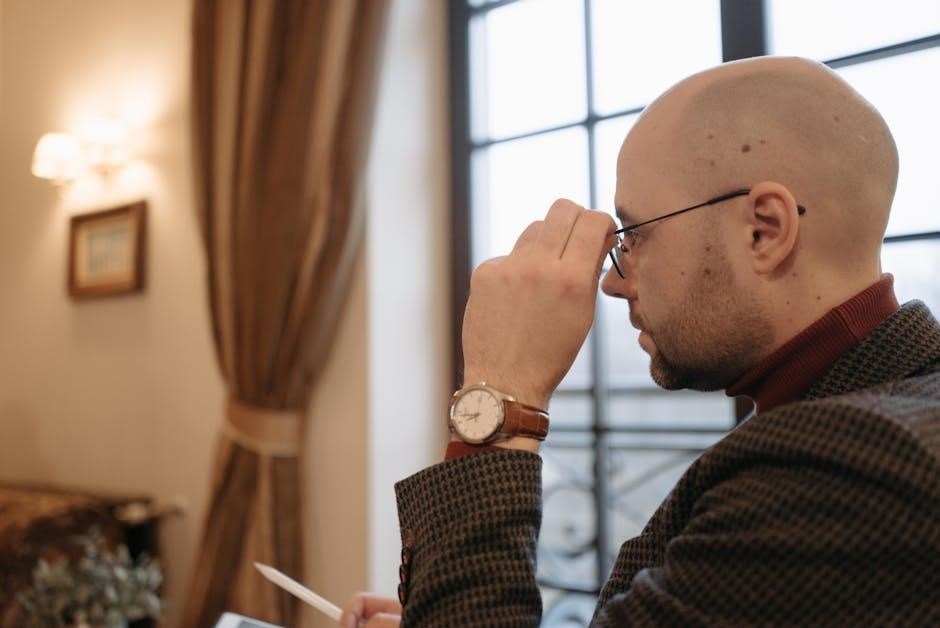Unit 1: History and Scope of Psychology
Explore the origins of psychology, from its roots in philosophy and biology to its establishment as a scientific discipline in 1879 by Wilhelm Wundt.
Discover how early psychologists like William James and Sigmund Freud shaped the field, and learn about the key theories and approaches that define modern psychology.
Understand the scientific method’s role in psychological research and how it helps psychologists study behavior, mental processes, and the factors influencing them.
Gain insights into the diverse applications of psychology in real-world scenarios, from education and health to workplace dynamics and social interactions.
Download comprehensive study guides and resources to master Unit 1 concepts, including timelines, biographies, and interactive exercises for deeper understanding;
1.1 Historical Development and Key Figures
Psychology emerged as a scientific discipline in 1879 with Wilhelm Wundt’s laboratory in Leipzig, marking the start of structured psychological research. Key figures like William James explored consciousness, while Sigmund Freud developed psychoanalysis. Edward Titchener introduced structuralism, focusing on breaking down mental processes. Meanwhile, Mary Whiton Calkins and Margaret Floy Washburn made significant contributions despite gender barriers. These pioneers laid the groundwork for modern psychology, shaping its theoretical foundations. Study guides like Myers’ Psychology for AP provide detailed timelines and biographies to aid understanding of these influential figures and their contributions.
1.2 Big Issues in Psychology
Psychology grapples with fundamental debates, such as nature vs. nurture, free will vs. determinism, and the mind-body problem. These issues shape research and theories, influencing how psychologists understand behavior and mental processes. For example, nature vs. nurture explores whether traits are innate or environmentally shaped, while free will vs. determinism debates the extent of personal control over actions. The mind-body problem examines the relationship between the mind and brain. These enduring questions guide psychological inquiry and are essential for understanding the field’s theoretical foundations. Study guides and resources, like Myers’ Psychology for AP, provide in-depth analyses to help students master these concepts.
1.3 Careers in Psychology
Careers in psychology span diverse fields, from clinical practice to research and education. Professionals can work as clinical psychologists, counselors, or neuropsychologists, helping individuals with mental health issues. Industrial-organizational psychologists focus on workplace behavior and productivity. Research psychologists contribute to academic and applied settings, exploring human behavior and cognition. Careers in psychology often require advanced degrees, with opportunities for specialization in areas like developmental, cognitive, or social psychology. Study guides, such as Myers’ Psychology for AP, provide insights into these paths, emphasizing the importance of internships and graduate studies for advanced roles.
1.4 Scientific Method in Psychology
The scientific method is a systematic approach to understanding behavior and mental processes. It involves making observations, forming hypotheses, and testing these through controlled experiments or studies. Data is analyzed to determine whether results support the hypothesis. This method emphasizes objectivity, replication, and peer review to ensure reliability and validity. Statistical analysis plays a key role in interpreting findings. By adhering to the scientific method, psychologists can establish cause-and-effect relationships and minimize bias. Study guides, such as those for AP Psychology, highlight the importance of this process in advancing psychological knowledge and maintaining scientific rigor.

Unit 2: Biological Bases of Behavior
The biological basis of behavior explores brain structure, nervous system functions, and the role of neurotransmitters and hormones in influencing behavior and cognitive processes.
2.1 Structure and Function of the Brain
The brain is the control center of the body, regulating behavior, cognition, and physiological processes. It consists of the cerebral cortex, brainstem, and limbic system. The cerebral cortex handles sensory input, memory, and decision-making, while the brainstem manages basic survival functions like breathing and heart rate; The limbic system, including the hippocampus and amygdala, plays a key role in emotion and memory formation. Neurotransmitters like dopamine and serotonin facilitate communication between neurons, influencing mood, motivation, and movement. Understanding brain structure and function is crucial for studying behavior and treating neurological and psychological disorders.
2.2 The Nervous System and Its Processes
The nervous system consists of the central nervous system (CNS) and peripheral nervous system (PNS). The CNS, including the brain and spinal cord, processes information and controls bodily functions. The PNS connects the CNS to sensory receptors and muscles, enabling communication. Sensory neurons transmit signals to the CNS, while motor neurons carry responses outward. Reflexes, like withdrawing a hand from heat, occur without conscious thought. The autonomic nervous system regulates involuntary actions, such as heart rate and digestion, through its sympathetic and parasympathetic divisions. Understanding these processes is essential for analyzing behavior and physiological responses.
2.3 Role of Neurotransmitters and Hormones
Neurotransmitters, such as serotonin and dopamine, play a crucial role in transmitting signals across synapses, influencing mood, motivation, and behavior. Imbalances can lead to disorders like depression or schizophrenia. Hormones, produced by endocrine glands, regulate various bodily functions. For example, adrenaline prepares the body for “fight or flight,” while insulin controls blood sugar levels. The hypothalamus and pituitary gland act as key regulators of hormone production, ensuring homeostasis. Understanding these chemical messengers is vital for exploring the biological basis of behavior and mental processes.

Unit 3: Sensation and Perception
Explore how we detect stimuli and interpret sensory information. Learn about thresholds, sensory adaptation, and perceptual processes that shape our understanding of the world.
3.1 Sensory Processes and Thresholds
The study of sensory processes reveals how we detect and interpret stimuli. Absolute threshold refers to the minimum intensity needed to detect a stimulus, while difference threshold is the smallest change noticeable. Sensory adaptation explains how prolonged exposure reduces sensitivity. These concepts highlight how our sensory systems filter and prioritize information. Understanding thresholds and adaptation is crucial for grasping perception and how we interact with our environment. Explore detailed explanations, diagrams, and practice questions in the AP Psychology study guide PDF for mastering this fundamental topic.
3.2 Perceptual Processes and Theories
Perception involves organizing and interpreting sensory information. Gestalt principles, like figure-ground and proximity, explain how we group stimuli into meaningful patterns. Top-down processing uses prior knowledge, while bottom-up relies on sensory input. Depth perception cues, such as binocular vision and relative size, help us perceive distances. Theories like constructive perception highlight how the brain actively interprets sensory data. These concepts are vital for understanding how we make sense of the world. The AP Psychology study guide PDF offers detailed explanations, examples, and practice questions to master perceptual processes and theories effectively.

Unit 4: Learning
This unit covers classical and operant conditioning, explaining how behaviors are learned through associations and reinforcement. The AP Psychology study guide PDF provides detailed examples and practice questions.
4.1 Classical Conditioning
Classical conditioning, discovered by Ivan Pavlov, explores how organisms learn associations between stimuli and responses. The AP Psychology study guide PDF details Pavlov’s experiments with dogs, demonstrating how neutral stimuli (e.g., bells) can elicit conditioned responses (salivation) when paired with unconditioned stimuli (food). Key concepts include unconditioned and conditioned stimuli and responses, as well as extinction and spontaneous recovery. These principles, applied to human behavior, show how environments shape reactions, making classical conditioning a foundational theory in understanding learning and behavior.
4.2 Operant Conditioning
Operant conditioning, developed by B.F. Skinner, focuses on how behavior is shaped by its consequences, such as rewards or punishments. The AP Psychology study guide PDF explains how positive reinforcement (e.g., treats) increases desired behaviors, while negative reinforcement (e.g., removing an unpleasant stimulus) also encourages behavior. Punishment, on the other hand, decreases undesired actions. Skinner’s work highlights schedules of reinforcement, such as fixed-ratio and variable-ratio, which influence response rates. This theory is widely applied in education, parenting, and workplace settings to modify behavior effectively.

Unit 5: Cognitive Psychology
Cognitive psychology explores mental processes like memory, language, and problem-solving. Discover how encoding, storage, and retrieval shape memory, and how theories like information processing explain cognition.
5.1 Memory: Types and Forgetting
Memory is categorized into sensory, short-term, and long-term types. Sensory memory briefly holds sensory data, while short-term memory retains information for a limited duration. Long-term memory stores information over extended periods. Forgetting occurs due to factors like the decay of memory traces, interference from new information, or the inability to retrieve stored information. Understanding these processes is crucial for strategies to enhance memory retention and reduce forgetting, as discussed in AP Psychology study guides and resources.
5.2 Language and Problem-Solving
Language involves the production and comprehension of verbal and nonverbal symbols, enabling communication and thought. Chomsky’s theory of universal grammar suggests an innate capacity for language acquisition. Problem-solving strategies include trial and error, algorithms, and heuristics, which vary in efficiency and accuracy. Cognitive biases, like confirmation bias, often influence decision-making, leading to systematic errors. Understanding these processes is essential for improving communication and critical thinking skills, as explored in AP Psychology study guides and resources.

Unit 6: Developmental Psychology
Examines human development across the lifespan, focusing on physical, cognitive, and psychosocial growth. Key theories include Piaget’s cognitive stages and Erikson’s psychosocial development, exploring challenges and milestones.
6.1 Development Across the Lifespan
Developmental psychology explores human growth and changes from infancy to adulthood. Key theories include Piaget’s cognitive stages and Erikson’s psychosocial development.
- Piaget’s Cognitive Stages: Sensorimotor, preoperational, concrete operational, and formal operational, focusing on how thinking evolves.
- Erikson’s Psychosocial Stages: Eight stages addressing trust, autonomy, identity, and intimacy, emphasizing social and emotional development.
- Kohlberg’s Moral Development: Pre-conventional, conventional, and post-conventional levels, explaining how moral reasoning progresses.
Understanding these theories helps explain milestones, challenges, and continuity in human development. Study guides provide detailed timelines and concept maps for better retention.

Unit 7: Motivation and Emotion
Explore theories of motivation, including drive-reduction and arousal, and understand biological and psychological explanations of emotions, such as the role of the brain and neurotransmitters.
7.1 Theories of Motivation
Understand the key theories explaining human motivation, such as drive-reduction theory, arousal theory, and Maslow’s hierarchy of needs. Drive-reduction theory suggests behavior is driven by reducing physiological needs, while arousal theory focuses on maintaining optimal stimulation levels. Maslow’s hierarchy organizes needs into a pyramid, from basic physiological to self-actualization. Additionally, explore self-determination theory, highlighting autonomy, competence, and relatedness as intrinsic motivators. These theories provide frameworks for understanding why people act and how motivation influences behavior in various contexts, such as education, work, and personal growth. Study guides offer detailed explanations and examples to master these concepts.
7.2 Biological and Psychological Theories of Emotion
Examine the biological and psychological theories explaining emotions, such as James-Lange, Cannon-Bard, and two-factor theory. The James-Lange theory posits emotions result from physiological responses, while Cannon-Bard suggests emotions occur simultaneously with physical reactions. Two-factor theory combines physiological arousal with cognitive labels to create emotional experiences. Additionally, explore the role of neurotransmitters and brain structures like the amygdala in emotion regulation. These theories highlight the interplay between biological processes and psychological interpretations, offering a comprehensive understanding of how emotions arise and are experienced. Study guides provide detailed diagrams and examples to clarify these complex interactions.
Unit 8: Personality
Explore the theories of personality, including psychoanalytic, trait, humanistic, and social learning approaches. Understand how these frameworks explain individual differences and behavior patterns in people.
Personality theories aim to explain the unique characteristics and behaviors of individuals. Major theories include psychoanalytic (Freud), trait (Big Five), humanistic (Rogers, Maslow), and social learning (Bandura) approaches. Each theory provides distinct insights into personality development, structure, and motivation. The psychoanalytic theory focuses on unconscious drives, while trait theory emphasizes stable personality dimensions. Humanistic theories highlight personal growth and self-actualization, and social learning theory stresses environmental influences and observational learning. Understanding these theories helps explain individual differences and behavior patterns. Download study guides for in-depth analysis and exam preparation.

Unit 9: Clinical Psychology
Explores psychological disorders and therapeutic interventions, providing insights into diagnosis, treatment, and mental health care. Download study guides for comprehensive exam preparation and in-depth understanding;
9.1 Overview of Psychological Disorders
Psychological disorders are patterns of thought, emotion, or behavior that impair daily functioning. The DSM-5 classifies disorders like anxiety, depression, and schizophrenia, outlining symptoms and diagnostic criteria.
Understanding causes, such as biological factors or environmental stressors, aids in diagnosis and treatment. Study guides provide detailed overviews, case studies, and exam-focused summaries to master this topic effectively.
9.2 Types of Therapies
Psychological therapies aim to treat mental disorders through various approaches. Cognitive-behavioral therapy (CBT) focuses on changing harmful thought patterns and behaviors. Psychodynamic therapy explores unconscious feelings and past experiences. Humanistic therapies, like person-centered therapy, emphasize personal growth and self-actualization. Biological therapies, such as medication and electroconvulsive therapy, target physical causes of disorders. Study guides detail these therapies, offering examples, case studies, and practice questions to help students master the material for the AP Psychology exam.

Unit 10: Social Psychology
Examines how social interactions influence behavior, including conformity, obedience, and group dynamics. Studies like Zimbardo’s Prison Experiment highlight social influence’s power on individual actions.
10.1 Social Influence and Behavior
Social influence shapes behavior through conformity, obedience, and group dynamics. Zimbardo’s Prison Study demonstrates how roles and environments can alter behavior. The Hawthorne Effect shows how observation changes actions. Attitudes form through social learning and cognitive dissonance. Groupthink and bystander effect highlight how groups impact decision-making and helping behaviors. Understanding these concepts helps explain real-world phenomena, such as peer pressure, leadership, and societal norms. Study guides offer strategies to master these topics, ensuring a deep grasp of how social forces mold individual and collective actions in various contexts.

Unit 11: Research Methods in Psychology
Master research methods, statistical reasoning, and critical thinking skills essential for psychological inquiry. Study guides and resources provide in-depth insights into scientific techniques and data analysis.
11.1 Scientific Research and Statistics
Delve into the fundamentals of scientific research and statistical analysis in psychology, crucial for understanding data interpretation and methodology. Study guides offer detailed explanations of experimental designs, correlation, and statistical reasoning, empowering students to critically evaluate research findings and apply these skills in their own studies. Resources include practice problems, concept reviews, and real-world examples to enhance comprehension of statistical concepts and their role in psychological research.





